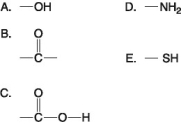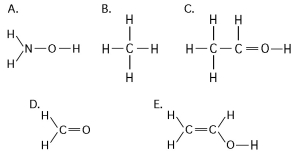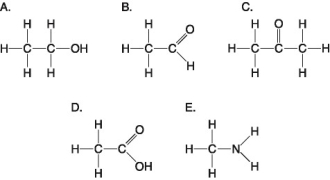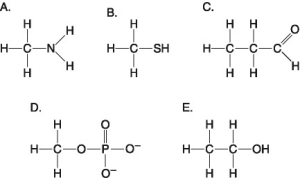A) A
B) B
C) C
D) D
E) E
Correct Answer

verified
Correct Answer
verified
Multiple Choice
Organic chemistry is currently defined as
A) the study of compounds made only by living cells.
B) the study of carbon compounds.
C) the study of vital forces.
D) the study of natural (as opposed to synthetic) compounds.
E) the study of hydrocarbons.
Correct Answer

verified
Correct Answer
verified
Multiple Choice
 -Which of the groups above is an acidic functional group that can dissociate and release H⁺ into a solution?
-Which of the groups above is an acidic functional group that can dissociate and release H⁺ into a solution?
A) A
B) B
C) C
D) D
E) E
Correct Answer

verified
Correct Answer
verified
Multiple Choice
 -Which of the structures illustrated above cannot form hydrogen bonds with water molecules?
-Which of the structures illustrated above cannot form hydrogen bonds with water molecules?
A) A
B) B
C) C
D) D
E) E
Correct Answer

verified
Correct Answer
verified
Multiple Choice
Hermann Kolbe's synthesis of an organic compound, acetic acid, from inorganic substances that had been prepared directly from pure elements was a significant milestone for what reason?
A) It solved an industrial shortage of acetic acid.
B) It proved that organic compounds could be synthesized from inorganic compounds.
C) It disproved the concept of vitalism.
D) It showed that life originated from simple inorganic chemicals.
E) It proved that organic compounds could be synthesized from inorganic compounds and disproved the concept of vitalism.
Correct Answer

verified
Correct Answer
verified
Multiple Choice
 -Which of the groups shown above is a functional group that helps stabilize proteins by forming covalent cross-links within or between protein molecules?
-Which of the groups shown above is a functional group that helps stabilize proteins by forming covalent cross-links within or between protein molecules?
A) A
B) B
C) C
D) D
E) E
Correct Answer

verified
Correct Answer
verified
Multiple Choice
 -Which molecule shown above has a carbonyl functional group in the form of an aldehyde?
-Which molecule shown above has a carbonyl functional group in the form of an aldehyde?
A) A
B) B
C) C
D) D
E) E
Correct Answer

verified
Correct Answer
verified
Multiple Choice
Answer the following questions based on the figure below.
 -Identify the asymmetric carbon in this molecule.
-Identify the asymmetric carbon in this molecule.
A) A
B) B
C) C
D) D
E) E
Correct Answer

verified
Correct Answer
verified
Multiple Choice
 -Which molecule shown above can increase the concentration of hydrogen ions in a solution and is therefore an organic acid?
-Which molecule shown above can increase the concentration of hydrogen ions in a solution and is therefore an organic acid?
A) A
B) B
C) C
D) D
E) E
Correct Answer

verified
Correct Answer
verified
Multiple Choice
 -Which molecule(s) shown above is (are) ionized in aqueous solution at pH 7?
-Which molecule(s) shown above is (are) ionized in aqueous solution at pH 7?
A) A
B) B and D
C) D and E
D) D
E) E
Correct Answer

verified
Correct Answer
verified
Multiple Choice
 -Which molecule shown above would have a positive charge in aqueous solution at pH 7?
-Which molecule shown above would have a positive charge in aqueous solution at pH 7?
A) A
B) B
C) C
D) D
E) E
Correct Answer

verified
Correct Answer
verified
Multiple Choice
How many electron pairs does carbon share in order to complete its valence shell?
A) 1
B) 2
C) 3
D) 4
E) 8
Correct Answer

verified
Correct Answer
verified
Multiple Choice
 -In which of the structures illustrated above are the atoms bonded by ionic bonds?
-In which of the structures illustrated above are the atoms bonded by ionic bonds?
A) A
B) B
C) C
D) C, D, and E only
E) none of the structures
Correct Answer

verified
Correct Answer
verified
Multiple Choice
 -Thalidomide and L-dopa, shown below, are examples of pharmaceutical drugs that occur as enantiomers, or molecules that
-Thalidomide and L-dopa, shown below, are examples of pharmaceutical drugs that occur as enantiomers, or molecules that

A) have identical three-dimensional shapes.
B) are mirror images of one another.
C) are structural isomers.
D) are mirror images of one another and have the same biological activity.
E) are cis-trans isomers.
Correct Answer

verified
Correct Answer
verified
Multiple Choice
 -Which functional group(s) shown above is (are) present in all amino acids?
-Which functional group(s) shown above is (are) present in all amino acids?
A) A and B
B) B and D
C) C only
D) D only
E) C and D
Correct Answer

verified
Correct Answer
verified
Multiple Choice
Testosterone and estradiol are
A) soluble in water.
B) structural isomers of each other.
C) proteins.
D) lipids.
E) enantiomers of each other.
Correct Answer

verified
Correct Answer
verified
Multiple Choice
What determines whether a carbon atom's covalent bonds to other atoms are in a tetrahedral configuration or a planar configuration?
A) the presence or absence of bonds with oxygen atoms
B) the presence or absence of double bonds between the carbon atom and other atoms
C) the polarity of the covalent bonds between carbon and other atoms
D) the presence or absence of bonds with nitrogen atoms
E) the solvent that the organic molecule is dissolved in
Correct Answer

verified
Correct Answer
verified
Multiple Choice
 -Which of the pairs of molecular structures shown below depict enantiomers (enantiomeric forms) of the same molecule?
-Which of the pairs of molecular structures shown below depict enantiomers (enantiomeric forms) of the same molecule?
A) ![]()
B) ![]()
C) ![]()
D) ![]()
E) ![]()
Correct Answer

verified
Correct Answer
verified
Multiple Choice
 -Which molecule shown above contains an amino functional group, but is not an amino acid?
-Which molecule shown above contains an amino functional group, but is not an amino acid?
A) A
B) B
C) C
D) D
E) E
Correct Answer

verified
Correct Answer
verified
Multiple Choice
Which of the following people was the first to synthesize an organic compound, urea, from inorganic starting materials?
A) Stanley Miller
B) Jakob Berzelius
C) Friedrich Wohler
D) Hermann Kolbe
E) August Kekulé
Correct Answer

verified
Correct Answer
verified
Showing 41 - 60 of 71
Related Exams